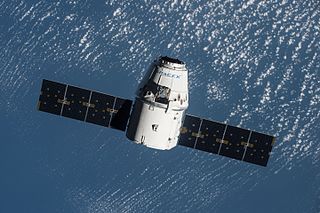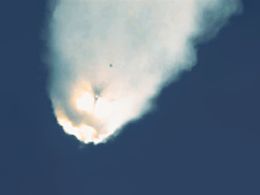
Cygnus is an expendable American cargo spacecraft developed by Orbital Sciences Corporation but manufactured and launched by Northrop Grumman Space Systems as part of NASA's Commercial Resupply Services (CRS) program. It is usually launched by Northrop Grumman's Antares rocket from the Wallops Flight Facility, although three flights were on ULA's Atlas V and three are planned for SpaceX's Falcon 9, in both cases launching from Cape Canaveral Space Force Station. It transports supplies to the International Space Station (ISS) following the retirement of the American Space Shuttle. Since August 2000, ISS resupply missions have been regularly flown by the Russian Progress spacecraft, as well as by the European Automated Transfer Vehicle, and the Japanese H-II Transfer Vehicle. With the Cygnus spacecraft and the SpaceX Dragon, NASA seeks to increase its partnerships with domestic commercial aviation and aeronautics industry.

Commercial Resupply Services (CRS) are a series of flights awarded by NASA for the delivery of cargo and supplies to the International Space Station (ISS) on commercially operated spacecraft. The first CRS contracts were signed in 2008 and awarded $1.6 billion to SpaceX for twelve cargo Dragon and $1.9 billion to Orbital Sciences for eight Cygnus flights, covering deliveries to 2016. The Falcon 9 and Antares rockets were also developed under the CRS program to deliver cargo spacecraft to the ISS.

SpaceX CRS-2, also known as SpX-2, was the fourth flight for SpaceX's uncrewed Dragon cargo spacecraft, the fifth and final flight for the company's two-stage Falcon 9 v1.0 launch vehicle, and the second SpaceX operational mission contracted to NASA under a Commercial Resupply Services (CRS-1) contract.

SpaceX CRS-8, also known as SpX-8, was a Commercial Resupply Service mission to the International Space Station (ISS) which was launched on April 8, 2016, at 20:43 UTC. It was the 23rd flight of a Falcon 9 rocket, the tenth flight of a Dragon cargo spacecraft and the eighth operational mission contracted to SpaceX by NASA under the Commercial Resupply Services program. The capsule carried over 3,100 kilograms (6,800 lb) of cargo to the ISS including the Bigelow Expandable Activity Module (BEAM), a prototype inflatable space habitat delivered in the vehicle's trunk, which was attached to the station and, as of May 2022, is expected to remain so for five more full years of in-orbit viability tests.

SpaceX CRS-4, also known as SpX-4, was a Commercial Resupply Service mission to the International Space Station (ISS), contracted to NASA, which was launched on 21 September 2014 and arrived at the space station on 23 September 2014. It was the sixth flight for SpaceX's uncrewed Dragon cargo spacecraft, and the fourth SpaceX operational mission contracted to NASA under a Commercial Resupply Services contract. The mission brought equipment and supplies to the space station, including the first 3D printer to be tested in space, a device to measure wind speed on Earth, and small satellites to be launched from the station. It also brought 20 mice for long-term research aboard the ISS.

SpaceX CRS-5, also known as SpX-5, was a Commercial Resupply Service mission to the International Space Station (ISS), conducted by SpaceX for NASA, and was launched on 10 January 2015 and ended on 11 February 2015. It was the seventh flight for SpaceX's uncrewed Dragon cargo spacecraft and the fifth SpaceX operational mission contracted to NASA under an ISS resupply services contract.

SpaceX CRS-6, also known as SpX-6, was a Commercial Resupply Service mission to the International Space Station, contracted to NASA. It was the eighth flight for SpaceX's uncrewed Dragon cargo spacecraft and the sixth SpaceX operational mission contracted to NASA under a Commercial Resupply Services contract. It was docked to the International Space Station from 17 April to 21 May 2015.

Dragon 2 is a class of partially reusable spacecraft developed, manufactured, and operated by American space company SpaceX, primarily for flights to the International Space Station (ISS). SpaceX also launches private missions, such as Inspiration4 and Axiom Space Missions. There are two variants of the Dragon spacecraft: Crew Dragon, a spacecraft capable of ferrying four crewmembers, and Cargo Dragon, a replacement for the original Dragon 1 used to carry freight to and from space. The spacecraft consists of a reusable space capsule and an expendable trunk module. The spacecraft launches atop a Falcon 9 Block 5 rocket and the capsule returns to Earth through splashdown. It has proven to be the most cost effective spacecraft in history to be used by NASA.

The International Docking Adapter (IDA) is a spacecraft docking system adapter developed to convert APAS-95 to support docking with spacecraft that implement the International Docking System Standard. The IDA uses NASA Docking System (NDS) hardware. An IDA was permanently installed on each of the International Space Station's (ISS) two open Pressurized Mating Adapters (PMAs), both of which are connected to the Harmony module.

SpaceX CRS-9, also known as SpX-9, is a Commercial Resupply Service mission to the International Space Station which launched on 18 July 2016. The mission was contracted by NASA and is operated by SpaceX using a Dragon capsule.

SpaceX CRS-12, also known as SpX-12, was a Commercial Resupply Services mission to the International Space Station launched on 14 August 2017. The mission was contracted by NASA and was flown by SpaceX using a new Dragon capsule. The Falcon 9 rocket's reusable first stage performed a controlled landing on Landing Zone 1 (LZ1) at Cape Canaveral Air Force Station. After delivering more than 2,900 kilograms (6,400 lb) of cargo, the Dragon spacecraft returned to Earth on 17 September 2017.

SpaceX CRS-13, also known as SpX-13, was a Commercial Resupply Service mission to the International Space Station launched on 15 December 2017. The mission was contracted by NASA and is flown by SpaceX. It was the second mission to successfully reuse a Dragon capsule, previously flown on CRS-6. The first stage of the Falcon 9 Full Thrust rocket was the previously flown, "flight-proven" core from CRS-11. The first stage returned to land at Cape Canaveral's Landing Zone 1 after separation of the first and second stage.

SpaceX CRS-14, also known as SpX-14, was a Commercial Resupply Service mission to the International Space Station launched on 2 April 2018. The mission was contracted by NASA and was flown by SpaceX. This mission reused the Falcon 9 first stage booster previously flown on CRS-12 and the Dragon capsule flown on CRS-8.

SpaceX CRS-15, also known as SpX-15, was a Commercial Resupply Service mission to the International Space Station launched 29 June 2018 aboard a Falcon 9 rocket. The mission was contracted by NASA and flown by SpaceX.

SpaceX CRS-16, also known as SpX-16, was a Commercial Resupply Service mission to the International Space Station launched on 5 December 2018 aboard a Falcon 9 launch vehicle. The mission was contracted by NASA and is flown by SpaceX.

SpaceX CRS-18, also known as SpX-18, was SpaceX's 18th flight to the International Space Station under the Commercial Resupply Services program for NASA. It was launched on 25 July 2019 aboard a Falcon 9 rocket.

SpaceX CRS-19, also known as SpX-19, was a Commercial Resupply Service mission to the International Space Station. The mission is contracted by NASA and was flown by SpaceX on a Falcon 9 rocket.

Dragon, also known as Dragon 1 or Cargo Dragon, was a class of fourteen partially reusable cargo spacecraft developed by SpaceX, an American private space transportation company. The spacecraft flew 23 missions between 2010 and 2020. Dragon was launched into orbit by the company's Falcon 9 launch vehicle to resupply the International Space Station (ISS).

SpaceX CRS-25, also known as SpX-25, was a Commercial Resupply Service mission (CRS) to the International Space Station (ISS) that was launched on 15 July 2022. The mission was contracted by NASA and was flown by SpaceX using their reusable spacecraft, the Cargo Dragon. The vehicle delivered supplies to the crew aboard the ISS along with multiple pieces of equipment that will be used to conduct multiple research investigations aboard the ISS.

SpaceX CRS-28, also known as SpX-28, is a Commercial Resupply Service mission to the International Space Station (ISS) launched on 5 June 2023. The mission was contracted by NASA and flown by SpaceX using Cargo Dragon C208. It was the eighth flight for SpaceX under NASA's CRS Phase 2.

























